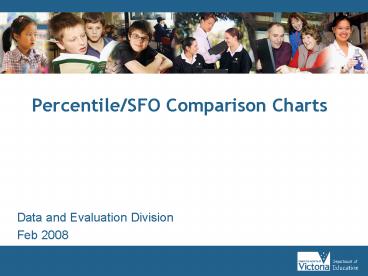PercentileSFO Comparison Charts - PowerPoint PPT Presentation
1 / 23
Title:
PercentileSFO Comparison Charts
Description:
Created so schools could compare their performance to 'similar schools' ... For each school, compare results to performance of 19 nearest schools (in terms ... – PowerPoint PPT presentation
Number of Views:35
Avg rating:3.0/5.0
Title: PercentileSFO Comparison Charts
1
Percentile/SFO Comparison Charts
- Data and Evaluation Division
- Feb 2008
2
Purpose of presentation
- To explain to schools the replacement for the
Like School Group approach, the Percentile/SFO
Comparison Charts.
3
Topics
- The Problem
- The Previous Solution (LSGs)
- Alternatives Considered
- Percentile/SFO Comparison Charts
4
The Problem
- How does my schools student achievement score
compare to other schools, given that my school is
different to the average school?
5
The Previous Solution - LSGs
- Like school groups (LSG) commenced in 1996
- Created so schools could compare their
performance to similar schools - 9 LSGs based on two measures
- EMA/Youth Allowance proportion of students in
school in receipt of EMA or Youth Allowance - LBOTE proportion of students from a language
background other than English
6
LSG chart
- Good acceptance overall, but weaknesses are now
apparent - Weaknesses include
- Schools close to a boundary (unfairly compared
to all schools in LSG) - EMA/Youth Allowance data no longer available
- LSGs are of unequal size (no. of schools in LSG4
is almost 10x that in LSG3)
7
Alternatives considered
- 1) Like School Sphere
- For each school, compare results to performance
of 19 nearest schools (in terms of SFO and maybe
LBOTE, enrolment) - Gets extremely complicated statistically
- 2) Percentile/SFO Comparison Charts
8
Student Family Occupation (SFO) densities
- Indicator of socio-economic status
- SFO accounts for 38 of variance in student
achievement - LBOTE only accounts for an additional 5
- Used in Student Resource Package
- 4 years of SFO data (2004-2007)
9
Student Family Occupation (SFO) densities how
calculated (extract from SRP Guide)
10
(No Transcript)
11
2005 SFOs for primary pri/sec schoolssorted
from highest to lowest socio-economic status (SES)
Lowest SES
22nd percentile
Highest SES
Highest SES
12
Nameless Primary School
13
2005 AIM Year 3 Reading mean scoressorted from
lowest to highest score
Lowest scoring school
Highest scoring school
14
Nameless Primary School
If socio-economic status, as measured by SFO, was
the sole determinant of student achievement,
youd expect the schools achievement percentile
to be in the same vicinity as the SFO percentile.
20 of schools have a lower AIM score
15
2005 SFOs for primary pri/sec schools sorted
from highest to lowest socio-economic status (SES)
Lowest SES
Highest SES
Highest SES
16
Nameless Primary School
The (up to) 20 of schools that are most like
this school in terms of SFO.
17
Nameless Primary School
18
Literacy
19
Literacy
20
Numeracy
21
Student Absence
22
Staff Opinion Survey
Parent Opinion Survey
Student (Attitudes to School) Survey
23
Value-add? No
- Not an attempt at value-add
- Simply is what it is
- If SFO was the sole determinant of student
achievement, a schools student achievement
percentile would be within the vicinity of its
SFO percentile. If its above (or below), the
school could hypothesise why.
24
Percentile/SFO Comparison Charts Principles
behind
- Use Student Family Occupation (SFO) only as best
predictor of student achievement - Examine student achievement and SFO percentiles
together - Keep it simple
- Use lots of data, over time, across strands
(dont rely on any one bit of data) - Combine the data with the school context to get
the full story






























